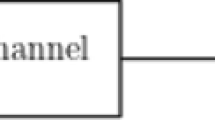Abstract
DURING the transmission of information, errors may occur because of the presence of noise, such as thermal noise in electronic signals or interference with other sources of radiation. One wants to recover the information with the minimum error possible. In theory this is possible by increasing the power of the emitter source. But as the cost is proportional to the energy fed into the channel, it costs less to code the message before sending it, thus including redundant 'coding' bits, and to decode at the end. Coding theory provides rigorous bounds on the cost-effectiveness of any code. The explicit codes proposed so far for practical applications do not saturate these bounds; that is, they do not achieve optimal cost-efficiency. Here we show that theoretical models of magnetically disordered materials (spin glasses) provide a new class of error-correction codes. Their cost performance can be calculated using the methods of statistical mechanics, and is found to be excellent. These models can, under certain circumstances, constitute the first known codes to saturate Shannon's well-known cost-performance bounds.
Similar content being viewed by others
References
McEliece, R. J. Encyclopedia of Mathematics and its Applications (Addison-Wesley, Reading, Massachusetts, 1977).
Clark, G. C. & Cain, J. B. Error-Correction Coding for Digital Communications (Plenum, New York, 1981).
Mézard, M., Parisi, G. & Virasoro, M. A. Spin Glass Theory and Beyond (World Scientific, Singapore, 1987).
Derrida, B. Phys. Rev. B 24, 2613–2626 (1981).
Gross, D. J. & Mézard, M. Nucl. Phys. B 240, 431–452 (1984).
Gardner, E. Nucl. Phys. B 257, 747–765 (1985).
Sherrington, D. & Kirkpatrick, S. Phys. Rev. Lett. 35, 1792–1796 (1975); Phys. Rev. B 17, 4384–4403 (1978).
Vannimenus, J., Toulouse, G. & Parisi, G. J. Phys. Paris 42, 565–571 (1981).
Kirkpatrick, S. in Lecture Notes in Physics 149, 280–301 (Springer, Berlin, 1981).
Kirkpatrick, S., Gelatt, C. D. & Vecchi, M. P. Science 220, 671–680 (1983).
Platt, J. C. & Hopfield, J. J. in Neural Networks for Computing (ed. Denker, J.) (American Institute of Physics, New York, 1986).
Author information
Authors and Affiliations
Rights and permissions
About this article
Cite this article
Sourlas, N. Spin-glass models as error-correcting codes. Nature 339, 693–695 (1989). https://doi.org/10.1038/339693a0
Received:
Accepted:
Issue Date:
DOI: https://doi.org/10.1038/339693a0
- Springer Nature Limited
This article is cited by
-
Direct observation of a dynamical glass transition in a nanomagnetic artificial Hopfield network
Nature Physics (2022)
-
Antiferromagnetic spatial photonic Ising machine through optoelectronic correlation computing
Communications Physics (2021)
-
A Spin Glass Model for Reconstructing Nonlinearly Encrypted Signals Corrupted by Noise
Journal of Statistical Physics (2019)
-
Maximum-Entropy Inference with a Programmable Annealer
Scientific Reports (2016)
-
Quantum annealing for the number-partitioning problem using a tunable spin glass of ions
Nature Communications (2016)





